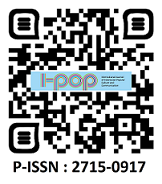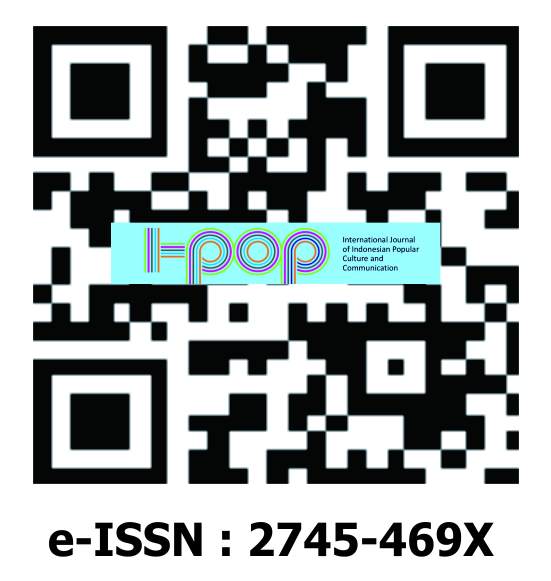From Distinction to Lifestyling
The Practices of Urban Women Midlife Consuming Popular Anti-Aging Skincare
DOI:
https://doi.org/10.36782/i-pop.v1i2.108Keywords:
Popular Skincare Product, Lower middle-class, Upper-class, Lifestyle, IdentityAbstract
Due to anti-aging popular products, people, especially urban women, can now delay aging. It changes the concept of aging and also influences how urban women think and act. This article examines the practices of middle-aged women, how they perceive using popular and trending anti-aging skincare, what motivated them to do so, and how women try not to grow old with specific goals. We interviewed ten women in urban areas, classified as midlife women aged 35 years and over. They comprised varied professions, classes, economic status, regional identity, age, and anti-aging products and brands. Interviews were unstructured to provide multiple opportunities and allow participants to talk flexibly about their practices and experiences using their own words. The findings indicated that there was a practice of life styling, namely behavior that merely demonstrated a particular lifestyle without being supported by economic capacity, which was the basis of actual consumption. Lower middle-class women demonstrated these practices, while the upper-class women's habits provided no less exciting insights. They consume anti-aging skin care for distinction purposes, as a practice of distinguishing oneself from others regarding appearance, social class, and identity.
Downloads
References
Calasanti, T., & King, N. (2015). Intersectionality and age. In Routledge handbook of cultural gerontology (pp. 215-222). Routledge.
Cohen, S. 2001, States of Denial: Knowing about Atrocities and Suffering, London : Wiley.
Clarke, L. H., & Griffin, M. (2008). Visible and invisible ageing: Beauty work as a response to ageism. Ageing & Society, 28(5), 653-674.
Diah, N. M. (2019). Physical changes as part of midlife crisis: the case of urban Malay women. Jurnal Sains Sosial: Malaysian Journal of Social Sciences, 3(1), 67-76.
Featherstone M. 1991, The Body in Consumer Culture dalam The Body : Social Prosess and Cultural Teori, Diedit oleh Featherstone, M. Hepworth dan B.S Turner, London, California, New Delhi: Sage Publication. Hal. 170.
Foucault, M. 1977, Disciplin and Punish. The Birth of the Prison, transl. Alan Sheridan, London-Worcester : Billing & Sons
Haryatmoko. (2015). Membongkar Rezim Kepastian: Pemikiran Kritis Post-Strukturalis. PT
Kanisius.
Gerke, S., 2000, Global Lifestyles under Local Conditions : the New Indonesian Middle Class, dalam Consumstion in Asia : Lifestyle and Identit. Di edit oleh Beng-Huat, Chua, London: Routledge, hal. 135
Gidden. A, Modernity and Self Identity : Self and Society in the Late Modern Age, Cambridge: Polity Press.
Gill, R., & Elias, A. S. (2014). ‘Awaken your incredible’: Love your body discourses and postfeminist contradictions. International Journal of Media & Cultural Politics, 10(2), 179-188.
Gosselink, C. A., Cox, D. L., McClure, S. J., & De Jong, M. L. (2008). Ravishing or ravaged: Women's relationships with women in the context of aging and western beauty culture. The International Journal of Aging and Human Development, 66(4), 307-327.
Kwak, E. K., Park, H. S., & Kang, N. M. (2014). Menopause knowledge, attitude, symptom and management among midlife employed women. Journal of menopausal medicine, 20(3), 118-125.
Mandiraatmadja, M, 2012, Gerakan anti-Penuaan : Politik Identitas Usia lanjut dalam Konstuksi Industri Medis, Disertasi: Universitas Gadjah Mada.
Murlianti, S, 2013. Tranformasi Kultural Elemen-Elemen Budaya Disiplin Klinis ke dalam Praktik Jasa Perawatan Kecantikan. dimuat pada Publikasi Ikatan Sosiologi Indonesia (internet) <https://www.academia.edu/7037018/Tranformasi_Kultural_Elemen> diakses tanggal (4 Oktober 2014)
Pickard, S., & Robinson, J. (2020) Ageing, the Body and the Gender Regime.
Rees Jones, I., & Hyde, M. (2008). Ageing in a consumer society: From passive to active consumption in Britain. Policy Press.
Tiidenberg, K. (2018). Visibly ageing femininities: women’s visual discourses of being over-40 and over-50 on Instagram. Feminist Media Studies, 18(1), 61-76.
Tracton-Bishop, B. (2012). Book Review: Facing Age: Women Growing Older in Anti-Aging Culture.
Toruan, 2008, http//www.qbheadlines.com/lifestyle (diunduh pada 2 Feberuari 2014)
http://surabaya.infoisinfo.co.id/cari/layanan-kecantikan (diunduh pada 4 Oktober 2014)
Sulaiman, Sabrina. (2021). Standar Kecantikan Indonesia, Seperti Apa Rupanya? https://harpersbazaar.co.id/articles/read/2/2021/14529/standar-kecantikan-di-indonesia-seperti-apa-rupanya (diunduh pada pada 02 Oktober 2021)









